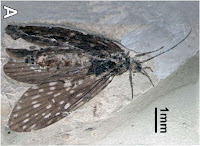Caddisflies,
Trichoptera, are an ancient Insect group with a fossil record dating
back to the Triassic. However, as with many Insect groups, the majority of
these specimens are compression fossils, which tend to preserve only
the wings, useful for determining the presence of a group and even
differentiating species, but telling us little about the actual
Insects. This makes amber deposits, which often preserve whole
Insects trapped in resin excreted by Trees, particularly interesting
to palaeoentomologists (scientists who study fossil Insects), as
these deposits show the whole morphology of the Insects, enabling
information about their biology and ecology to be inferred.
In a
paper published in the journal Cretaceous Research on 29 September
2016, Wilfried Wichard of the Institute of Biology at the Universityof Koeln, and Bo Wang of the State Key Laboratory of Palaeobiologyand Stratigraphy at the Nanjing Institute of Geology and Palaeontology and the Key Laboratory of Zoological Systematics and Evolution at the Institute of Zoology of the Chinese Academy ofScience, describe a new species of Caddisfly from Burmese Amber
collected from a mine near the village of Noije Bum in Kachin State,
Myanmar.
The new
species is named Palaeopsilotreta xiai, where
'Palaeopsilotreta' means 'Ancient Psilotreta',
PsilotretaI being a modern
genus that the specimen closely resembles, and 'xiai'
honours Xia Fangyuan of the Lingpoge Amber Museum for his work on
Burmese Amber. The species is described from three male specimens,
essentially similar to members of the modern genus Psilotreta,
excepting their remarkable antennae, which are bipectinate along much
of their length; that is to say they have a double row of rami
(comb-like structures) on the antennae, with a pair of rami arising
from each of the antennae joints.
Palaeopsilotreta
xiai, first specimen. Wichard &
Wang (2016).
Branching,
comb-like or feathery structures on the antennae of Insects are
generally associated with an improved sense of smell. Such structures
are most common in Moths and Beetles and are typically found in
species where the male locates females by following a pheromone scent
she emits, and in such species it is usually only the males that have
such antenae. No Caddisfly with bipectinate antennae has previously
been recorded, though there are several species with pectinate
antennae (i.e. antennae that have a single row of rami) known from
modern Vietnam. Curiously, all of these modern Vietnamese species are
known from their males only (i.e. no females have been found for any
of these species), so it is unknown if the females of these species
have simple or pectinate antennae, a situation also seen in
Palaeopsilotreta xiai,
which is described from male specimens only.

Second
specimen of Palaeopsilotreta xiai.
Wichard & Wang (2016).
Due
to the close resemblance of Palaeopsilotreta xiai
to the modern genus Psilotreta,
it is considered to be a member of the same family, the
Odontoceridae, a group with a fossil record that previously only
extended back to the Eocene. Amber from the Noije Bum Mine is encased
in a volcanoclastic matrix (i.e. a sediment of volcanic origin,
typically an ashfall or lahar deposit), which has been dated to 98.8
million years ago using uranium-lead dating of zircon crystals
(zircon is a mineral formed by the crystallization of cooling lavas; when
it forms it often contains trace amounts of uranium, which decays into - amongst other things - lead at a
known rate; since lead - which has a much lower melting point - will not have crystalized out of the original
lava as the zircon formed, it is possible to calculate the age of a zircon crystal from the
ratio between these elements.); it is assumed that the amber is slightly, but not
significantly, older than the matrix, making the amber a little under
100 million years old.
See also...
 A Caddisfly from the Middle Jurassic of Inner Mongolia. Caddisflies (Trichoptera) are a widespread and numerous (over 12 000
described species) group of Insects closely related to the Lepidoptera
(Butterflies and Moths). Like Butterflies and Moths...
A Caddisfly from the Middle Jurassic of Inner Mongolia. Caddisflies (Trichoptera) are a widespread and numerous (over 12 000
described species) group of Insects closely related to the Lepidoptera
(Butterflies and Moths). Like Butterflies and Moths...
Follow Sciency Thoughts on Facebook.

